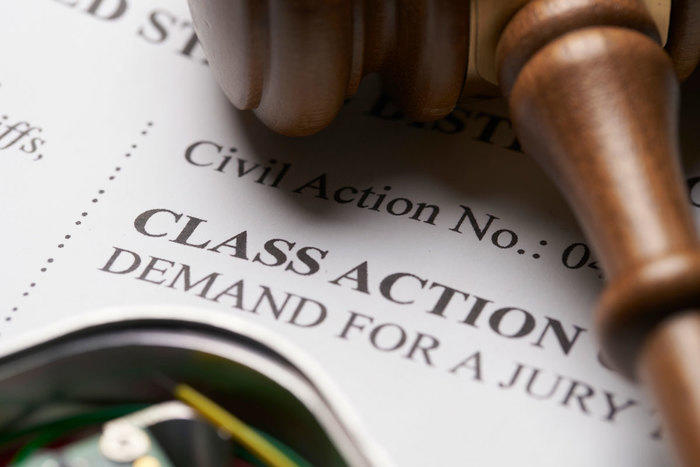Browsing the BioVie Class Action Lawsuit: What You Required to Know
Browsing the BioVie Class Action Lawsuit: What You Required to Know
Blog Article
Discovering Course Activity Legal Actions: What You Need to Know
Course activity lawsuits have actually ended up being increasingly widespread in today's legal landscape, with people joining pressures to seek remedy against firms and companies. In this conversation, we will check out the ins and outs of class activity legal actions, dropping light on their definition, the needs for filing, and the possible benefits and disadvantages involved.
The Interpretation of Class Activity Suits
Just what is the interpretation of a course action legal action? A class action claim is a lawsuit submitted by a group of individuals that have comparable cases against an accused. It allows a a great deal of individuals, referred to as the class members, to collaborate and seek their cases collectively, as opposed to each specific filing a separate lawsuit. When the number of potential plaintiffs is also large for individual claims to be sensible, Class action suits are commonly brought. They are frequently made use of in instances entailing consumer protection, product liability, securities fraud, and employment issues.
Among the essential components of a course activity lawsuit is that the lead plaintiff, also known as the class rep, stands for the rate of interests of all the class members. The court appoints the lead complainant based upon their capability to fairly and sufficiently represent the class. The lead complainant functions carefully with the class action lawyer to look for and develop a strong case payment or other solutions on part of the entire class.
In order for a course activity legal action to continue, the court should accredit the class. This means that the court identifies that the lawsuit meets particular needs, such as numerosity (a big enough variety of class members), commonality (usual inquiries of legislation or reality), typicality (the cases of the lead plaintiff are typical of the class), and adequacy of representation (the lead plaintiff and class counsel can representing the course's passions) As soon as the class is licensed, the lawsuit can move on, and any kind of judgment or negotiation got to will relate to all course participants unless they pick to opt-out.
Class activity lawsuits serve an important objective in offering accessibility to justice for people that may not have the sources to pursue their cases separately. They additionally promote performance in the lawful system by settling comparable claims right into a single activity, reducing the problem on both the court and the events involved.
Demands for Submitting a Course Action Suit

One more demand is that the course needs to be adequately many. The specific variety of course participants needed may vary depending upon the jurisdiction and the nature of the case. However, it is typically expected that the class must be huge enough that joining all the individual plaintiffs right into a solitary legal action is extra reliable than having several separate suits.
Additionally, it is vital that the class agent, who is the individual or entity bringing the lawsuit in support of the course, has typical claims and defenses to those of the class participants. The rep has to additionally have the ability to properly and fairly represent the rate of interests of the whole course.

Benefits and Downsides of Class Activity Lawsuits
Class action claims provide both advantages and downsides for complainants and defendants associated with the lawful process. On the one hand, one of the considerable advantages of course action lawsuits is that they supply a affordable and efficient method for people with comparable cases to go after justice collectively. By consolidating countless similar cases right into one suit, course activities improve the legal procedure and save time and sources for both offenders and complainants.
An additional benefit of course activity suits is that they allow people with limited resources to seek compensation for their damages. In cases where the potential healing is little, individual suits may not be financially sensible. Nevertheless, by signing up with pressures in a class activity, complainants can pool their resources and raise their possibilities of obtaining a fair resolution.
Additionally, class actions can promote social modification by holding firms responsible for their activities. By bringing interest to prevalent misconduct or defective items, class actions can push business to transform their methods, boost product safety and security, or apply reforms.
However, course actions additionally have drawbacks. One prospective negative aspect is that individual plaintiffs might have restricted control over the litigation process and the ultimate result of the situation. The lead complainants Visit Website and their lawyers usually make crucial choices on behalf of the entire class, which might not constantly align with the specific interests of each course member.
In addition, course actions can be lengthy and time-consuming, frequently taking years to get to a resolution. The complexity and size of these suits can bring about hold-ups and extended litigation, which can be annoying for both plaintiffs and offenders looking for a timely resolution.
Actions Included in a Class Activity Claim
The process of a class activity suit typically starts with the recognition of a possible class and the filing of a complaint. As soon as a team of individuals that share comparable insurance claims against an accused is recognized, the lead plaintiff, or class rep, submits a grievance in behalf of the entire course. This problem details the supposed wrongdoing and seeks damages or various other relief for all participants of the class.
After the i loved this issue is filed, the court will certainly figure out whether the case fulfills the requirements for course qualification. These needs commonly consist of numerosity (a big enough course), commonality (comparable lawful claims), typicality (the lead complainant's cases are representative of the class), and adequacy of representation (the lead plaintiff and their lawyer can appropriately represent the class's interests)
If the court certifies the class, notification is provided to all potential course participants, offering them the opportunity to opt-out if they desire to pursue their very own specific cases - Archer-Daniels-Midland class action lawsuit. If a sufficient variety of class members stay, the case will continue to the discovery phase, where both sides collect evidence and information relevant to the claims
Following discovery, the celebrations might take part in settlement arrangements or proceed to trial. If the situation goes to trial and the course prevails, the court will establish the suitable damages or alleviation to be granted to the course participants.
Current Site Course Activity Claims
With a strong check that understanding of the actions included in a course activity legal action, it is currently important to analyze some recent site situations that have actually made a substantial influence in the lawful landscape. Archer-Daniels-Midland class action lawsuit. These cases have not just formed the means course action claims are carried out however have also brought about adjustments in numerous markets
One such site situation is the Volkswagen discharges rumor, which led to the largest course activity negotiation in auto history. This deceptiveness affected millions of customers worldwide, leading to a course activity legal action.
An additional notable instance is the Johnson & Johnson talc suit. Hundreds of women filed suits against the company, claiming that their talcum powder items created ovarian cancer cells. In 2018, a court awarded $4.7 billion in damages to 22 complainants. This case elevated problems about the safety and security of talcum powder and motivated Johnson & Johnson to modify their product labeling.
These recent site instances demonstrate the power of class action legal actions in holding corporations responsible for their activities and seeking justice for afflicted people. They function as examples of just how class activity lawsuits can bring around considerable changes and secure the rights of consumers.
Final Thought
In final thought, class action lawsuits are a legal mechanism that permits a team of individuals to collectively look for justice for a common complaint. Understanding the requirements and actions involved in filing a class activity legal action is critical for people looking for to seek this legal opportunity.
One of the crucial components of a course action legal action is that the lead plaintiff, likewise recognized as the course rep, stands for the passions of all the class participants.In order for a class action claim to continue, the court should license the course. This suggests that the court identifies that the legal action meets certain requirements, such as numerosity (a large enough number of course participants), commonness (typical questions of law or truth), typicality (the insurance claims of the lead complainant are normal of the course), and adequacy of depiction (the lead complainant and course guidance are qualified of representing the course's passions) As soon as the class is licensed, the suit can relocate onward, and any kind of judgment or settlement reached will use to all class participants unless they pick to opt-out.
The procedure of a class action suit generally begins with the identification of a possible course and the declaring of a complaint.
Report this page